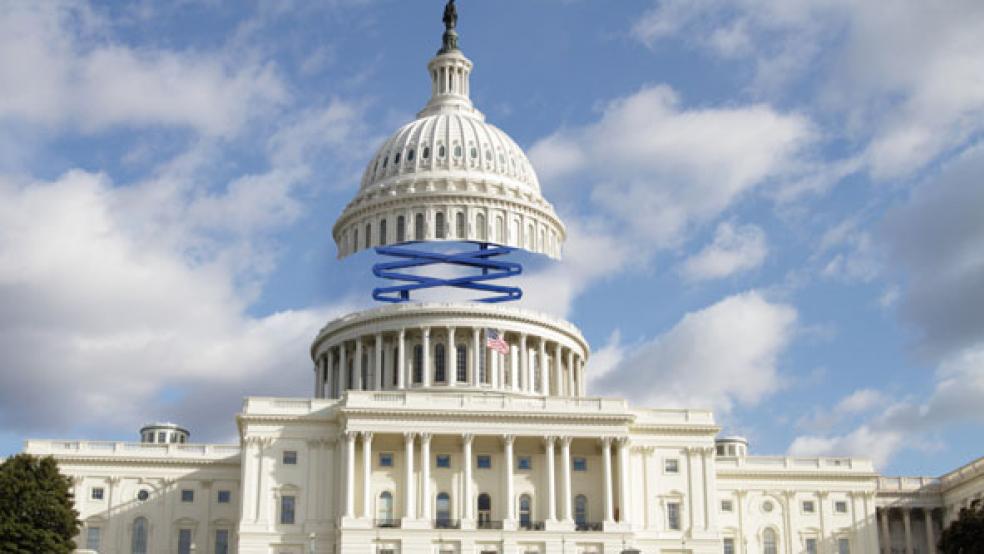With relatively little time left before it begins to run out of borrowing authority, the Treasury could soon be forced to pick and choose between paying interest on the national debt and mailing Social Security checks to retirees and paying defense contractors and keeping the federal government fully operating.

A year and a half after weathering the last debt ceiling crisis, Treasury officials are bracing for another bruising battle between the Obama Administration and congressional Republicans over terms for extending the government’s borrowing authority beyond the current $16.4 trillion limit. Technically, the Treasury bumped into that limit on Jan. 1, but has begun employing a series of budget gimmicks at its disposal to buy some extra time.
Yet the government will be unable to pay all of its bills as early as Feb. 15, or the “X Date,” according to Steve Bell, a senior official at the Bipartisan Policy Center. “Our numbers show that we have less time to solve this problem than many realize,” Bell told reporters at a briefing on Monday. “It will be difficult for Treasury to get beyond the March 1 date in our judgment.”
That could trigger a worse-case scenario, in which cash-strapped government officials would have to pick winners and losers in deciding who gets paid and who doesn’t.
Treasury officials have repeatedly made it clear that their foremost responsibility is making sure that U.S. bond holders -- including China and Japan -- receive their interest payments in a timely fashion. Failure to do that would touch off an international economic crisis. Moreover, government officials and politicians view Social Security and veteran benefits and military pay as sacrosanct.
But if they began to run out of cash, Treasury officials would have to consider a number of draconian moves to keep the government afloat – such as delaying billions of dollars of income tax refunds, postponing Medicare and Medicaid payments to providers, cutting off food stamps and furloughing government workers, according to experts. In many ways, a default on the debt would prove to be far more damaging than a government shutdown.
“When the government shut down in the 1990s, Social Security payments still went out,” said Brian Collins, an analyst with the Bipartisan Policy Center. “Now, maybe if you needed to get someone at the Social Security Administration with a problem, you might not have been able to because they were on furlough. But the payments for Social Security went out, the payment for Medicaid went out, tax return payments went out, essential personnel were retained.”
“Under this scenario, we hit the ‘X Date,’ and don’t lift the debt ceiling, there are people who actually are not going to get paid,” he said. “It’s either going to be tax refunds or Medicare and Social Security. There will actually be people who don’t get their checks that are owed to them.”
SUDDENLY LAST SUMMER
Back in the summer of 2011, the Treasury came within a day of defaulting on its debt for the first time in history. At the last minute, the administration and congressional leaders grudgingly reached agreement on a plan to simultaneously reduce spending and raise the debt ceiling. Despite that agreement, Standard & Poor’s downgraded the government’s sterling AAA rating by one notch – in part, as a warning against further government brinksmanship. Yet in the wake of last week’s near-disaster – when the administration and Congress narrowly averted the fiscal cliff – Washington is staring at the prospect of yet another debt ceiling crisis early this year that may well lead to another credit downgrading or worse.
“Think about what we’re talking about here,” said Bell, a former Senate Republican budget aide. “We’re talking about the reserve currency of the world. We’re talking about the deepest and most liquid markets in the world. . . And we’re talking about the possibility of [the United States] not meeting its financial obligations.”
House Speaker John Boehner, R-Ohio, and Senate Minority Leader Mitch McConnell, R-Ky., have threatened to block approval of a new, higher debt ceiling until President Obama agrees to major spending cuts and entitlement reforms to go along with the tax increases approved last week as part of the fiscal cliff agreement.
“It's a shame that we have to use whatever leverage we have in Congress to get the president to deal with the biggest problem confronting our future—and that's our excessive spending,” McConnell said over the weekend on NBC’s “Meet the Press” program. “If we're not going to deal with it now, when are we going to deal with it? And we've watched the government explode over the last four years. We've dealt with the revenue issue.”
Obama has vowed to never again negotiate the terms of the debt ceiling, arguing that once the government reaches its statutory borrowing limit, Congress should have no choice but to raise it to avoid a damaging default on borrowing from China, Japan and other major U.S. creditors. “If Congress refuses to give the United States the ability to pay its bills on time, the consequences for the entire global economy could be catastrophic,” Obama said over the weekend. “Our families and our businesses cannot afford that dangerous game again.
Treasury Secretary Timothy F. Geithner said on Dec. 26 that his department is resorting to “extraordinary measures” to raise about $200 billion of additional cash to meet government obligations over the next month or so while Obama and Congress hammer out their differences over the debt ceiling. Geithner used many of these same tactics in 2011such as postponing reinvestments in the Federal Employees’ Retirement System G Fund and not investing in the Exchange Stabilization Fund to buy about four months of extra time before facing actual default.
A BAG FULL OF FEWER TRICKS
This time around, Geithner has fewer tricks in his bag, which means negotiators will have only about six to eight weeks to agree on a new debt ceiling before the Treasury actually begins to run low on cash. Budget experts project that sometime between Feb. 15 and March 1, the Treasury will exhaust its borrowing authority and will no longer have sufficient funds to pay all of its bills in full and on time.
The Treasury has never failed during a previous debt limit impasse to meet a payment obligation. Once the Treasury hits that so-called “X date” for actually exhausting its borrowing authority, the government’s cash flow problems would become evident practically overnight. At that point, the government will be unable to pay roughly 40 percent of its debts and obligations, according to a new analysis of Treasury daily and monthly statements by the Bipartisan Policy Center.
Between Feb. 15 and March 15, the Treasury’s scheduled government payments and interest costs will total $452 billion, but projected revenue would be only $277 billion – leaving a net operating revenue shortfall of $175 billion, according to the BPC study.
In prioritizing its payments for that period, the Treasury would have to choose between these bills coming due:
- IRS refunds to individuals -- $86 billion.
- Medicare and Medicaid -- $73 billion
- Social Security -- $61 billion
- Interest on the debt -- $38 billion
- Defense vendor payments -- $29 billion
- Food Stamps/HUD/Welfare/unemployment -- $22 billion
- Federal salaries/benefits -- $20 billion
- Department of Education -- $17 billion
- Other federal departments and programs -- $106 billion
There are a few factors that could work in the administration’s favor in forestalling default: February is a big month for federal tax returns – when the government typically sends out about $100 billion in refunds. If the IRS delays making refunds until March 1, that could put off the ‘‘X-Date” for four or five weeks. Another possibility would be adding substantially to the $20 billion a month that the Federal Reserve transfers to the Treasury on a weekly basis.
“If we reach the “X Date” and Treasury is forced to prioritize payments, handling payments for many important and popular programs will quickly become impossible, causing disruption to an already fragile economic recovery,” said Bell.
In addition to prioritization of payments, Treasury must also roll over roughly $500 billion in debt that matures in the Feb. 15-March 15 period. Finally, BPC predicts that a debt limit increase of $1.1 trillion would be needed to fully fund the government through the end of 2013 and another $1 trillion through the end of 2014.





